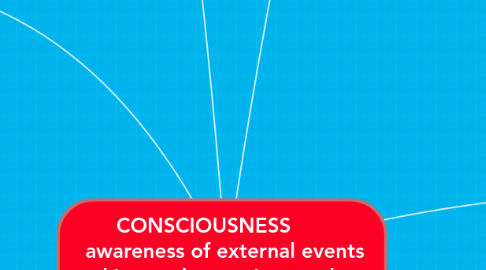
1. THE NATURE OF CONSCIOUSNESS
1.1. Theory of Mind
1.1.1. individuals' understanding about themselves and others
1.2. Level of Awareness
1.2.1. Higher-level
1.2.2. Lower-level
1.2.3. Altered-states
1.2.4. Subconscious
1.2.5. No awareness
1.3. Process
1.3.1. Controlled
1.3.2. Automatic
2. HYPNOSIS (best combined with psychotherapy)
2.1. altered state of consciousness
2.2. Steps
2.2.1. 1.Minimizing distractions
2.2.2. 2.Concentrate on something specific
2.2.3. 3.Expection
2.2.4. 4.Suggestions
2.3. uses
2.3.1. dampen brain processes
2.3.2. helps understanding
2.3.2.1. brain function
2.3.2.2. effects of hypnosis
3. MEDITATION
3.1. obtaining peaceful state of mind by mindfulness meditation
4. SLEEP
4.1. Biological rhythms
4.1.1. Suprachiasmatic nucleus (SCN)
4.1.2. Biological clock
4.1.2.1. Desynchronizing
4.1.2.2. Resetting
4.1.3. Circadian rhythms
4.2. Why do we sleep??
4.2.1. Brain plasticity
4.2.2. Restoration
4.2.3. Protection
4.2.4. Conserve energy
4.3. Waves
4.3.1. Alpha
4.3.2. Beta
4.3.3. Theta
4.3.4. Delta
4.4. Stages
4.4.1. 1
4.4.2. 2
4.4.3. 3
4.4.4. 4
4.5. Brain
4.5.1. reticular formation (for sleep and arousal)
4.5.2. c
4.5.2.1. serotonin
4.5.2.2. NE
4.5.2.3. Ach
4.6. And this happen when....we didn't get enough sleep!
4.6.1. Obesity and heart disease
4.6.2. lmmune system and infection
4.6.3. Stroke and asthma
4.6.4. Alzheimer disease,stroke and cancer
4.6.5. Mental disorders
4.7. Sleep disorders
4.7.1. Insomnia
4.7.2. Night terrors
4.7.3. Narcolepsy
4.7.4. Sleep apnea
4.7.5. Somnambulism
4.7.5.1. Sleep walking
4.7.5.2. Sleep talking
4.7.5.3. Sleep eating
5. PSYCHOACTIVE DRUGS
5.1. c
5.1.1. alter consciousness
5.1.2. c
5.1.3. c
5.2. Addiction (refers to physical and physchological dependence or both)
5.3. Stimulants
5.3.1. c
5.3.1.1. cocaine
5.3.1.2. nicotine
5.4. Hallucinogens (psychedelic drugs)
5.4.1. modify a person's perceptual experience
5.4.2. produce unreal vision
5.4.3. marijuana,LSD
